You are using an out of date browser. It may not display this or other websites correctly.
You should upgrade or use an alternative browser.
You should upgrade or use an alternative browser.
Freelander 1 Return of the (Land) Rovers: Kilo-Hippo-Delta
- Thread starter rob_bell
- Start date
This site contains affiliate links for which LandyZone may be compensated if you make a purchase.
Alibro
Well-Known Member
- Posts
- 7,449
- Location
- Northern Ireland
As you know the biggest fear of buying a car with a blown head gasket is that it was driven on and overheated massively causing damage to the head. Knowing how daft you are may I suggest you look for a 1.8T and install it. There is a thread here where a guy did that with great success, claiming 0-60 times around 7 seconds. 
I have a complete 1.8T engine in my garage Alibro. As you do. 
That might happen - but not yet: I want to see how the car feels at the moment under normal power. I haven't found the 1.8T Freelander thread yet, but I've heard about it. Absolutely nutty: I love it! My other approach would be supercharge the engine. Either a turbo block (which would make most sense), or the standard engine (which will tolerate a light boost on standard internals). Supercharging would give more low-end torque I think - and therefore better suited to a Hippo?
And then there is option three: fit a decent 4-2-1 exhaust manifold to the standard engine. My MGF, with little other modification, makes a 141 ft.lb with a torque curve that looks like the silhouette of Table Mountain. I reckon this would work really exceptionally well on the Hippo - and I am a little more tempted to go down this route in preference in the first instance.
But first, get Kilo-Hippo-Delta back on the road!
That might happen - but not yet: I want to see how the car feels at the moment under normal power. I haven't found the 1.8T Freelander thread yet, but I've heard about it. Absolutely nutty: I love it! My other approach would be supercharge the engine. Either a turbo block (which would make most sense), or the standard engine (which will tolerate a light boost on standard internals). Supercharging would give more low-end torque I think - and therefore better suited to a Hippo?
And then there is option three: fit a decent 4-2-1 exhaust manifold to the standard engine. My MGF, with little other modification, makes a 141 ft.lb with a torque curve that looks like the silhouette of Table Mountain. I reckon this would work really exceptionally well on the Hippo - and I am a little more tempted to go down this route in preference in the first instance.
But first, get Kilo-Hippo-Delta back on the road!
I have a complete 1.8T engine in my garage Alibro. As you do.
That might happen - but not yet: I want to see how the car feels at the moment under normal power. I haven't found the 1.8T Freelander thread yet, but I've heard about it. Absolutely nutty: I love it! My other approach would be supercharge the engine. Either a turbo block (which would make most sense), or the standard engine (which will tolerate a light boost on standard internals). Supercharging would give more low-end torque I think - and therefore better suited to a Hippo?
And then there is option three: fit a decent 4-2-1 exhaust manifold to the standard engine. My MGF, with little other modification, makes a 141 ft.lb with a torque curve that looks like the silhouette of Table Mountain. I reckon this would work really exceptionally well on the Hippo - and I am a little more tempted to go down this route in preference in the first instance.
But first, get Kilo-Hippo-Delta back on the road!
How about a turbo VVC engine then
I'm not sure having a flat torque curve is necessary a good thing tbh. It's better to see a high low RPM torque curve over a flat one.
Alibro
Well-Known Member
- Posts
- 7,449
- Location
- Northern Ireland
And then there is option three: fit a decent 4-2-1 exhaust manifold to the standard engine. My MGF, with little other modification, makes a 141 ft.lb with a torque curve that looks like the silhouette of Table Mountain. I reckon this would work really exceptionally well on the Hippo
But first, get Kilo-Hippo-Delta back on the road!
How did you get 141 Ftlb of torque out of a NASP K series? That's a hell of an increase over standard.
Mike has built a VVC turbo - and it really flies 
The torque curve on the MPi engine rises slowly to a peak, but has an annoying dip at 3,500 rpm (I see it all the time on the rolling road). The 4-2-1 fills this in, and boosts low-end torque significantly. The MG will pull 20mph in 4th without hesitation or judder. It's that good. I think it would suit the Hippo very nicely - but would likely cost the thick end of £500, so not necessarily cheap.
Brill - thanks!
The torque curve on the MPi engine rises slowly to a peak, but has an annoying dip at 3,500 rpm (I see it all the time on the rolling road). The 4-2-1 fills this in, and boosts low-end torque significantly. The MG will pull 20mph in 4th without hesitation or judder. It's that good. I think it would suit the Hippo very nicely - but would likely cost the thick end of £500, so not necessarily cheap.
Brill - thanks!
Yikes - typo. 131 (IIRC). But even so, massive gain. I'll see whether I can find the curves...How did you get 141 Ftlb of torque out of a NASP K series? That's a hell of an increase over standard.
You must be doing some clever there.Yikes - typo. 131 (IIRC). But even so, massive gain. I'll see whether I can find the curves...
My modified MGF VVC with a 160 head, long primary exhaust, sport cat and system with a cold air feed and huge air filter only just makes 130 Ftlb
To get that out of a non VVC is very good going. Hell thats on a few Ftlb short of K turbo torque.
Sorry Nodge - I'm doing something stupid. Right number, wrong units. 131bhp, 141 Nm (104 lb.ft)
Still pretty impressive and the car really does pull like a diesel.
Easy done. But I suspect your still wrong but the other way!!
The standard 1.8 K makes a good solid 118Ftlb all day long. The Freelander version is mapped to produce this at 2750 Rpm. The normal car 1.8 has slightly different mapping which pushes the same 118Ftlb up to 4000 Rpm.
The original 143 Bhp VVC (VVC MGF, BRM R200) makes 123Ftlb, but with a nice flat torque curve. The 157 BHP VVC (ZR160) makes 127Ftlb with the same flat torque curve.
With some well chosen breathing mods, the 157 VVC will make 130 to 132Ftlb. This basically pushes it power to about 180 BHP. Not to shabby for a 30+ year old design of engine. I love the K series engine but I don't think it was best suited to the heavy Freelander body.
The T series would have been a better choice, but sadly, it couldn't be made to meet the emissions requirements, so it wasn't used.
The KV6 was perfect, but it should have been available in a manual box. This would have been more fuel efficient, compared to the auto box used.
I hope you enjoy your Freelander
I am living in befuddlement Nodge! I found this power curve when I was trying out an "up-rated" fuel pressure regulator (clear demonstration that they are pointless on a largely standard engine running standard engine management):
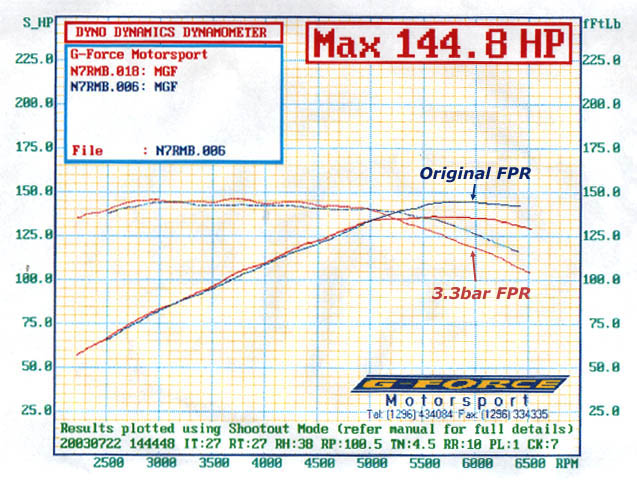
This is a DynoDymnamics rolling road - these load cells don't do run down curves, so you have to estimate transmission losses. This one is over-estimating the losses, and therefore over estimating power at the flywheel, but you get the impression of the curves. I've also have curves from Dave Walker's highly respected RR, and also Bernard's RR which are almost identical (he's calibrated his DD RR almost perfectly for the MGF). I'll find the numbers!
But yes, really excited about getting Kilo-Hippo-Delta back on the road (or perhaps more accurately, back onto the "green road")!
This is a DynoDymnamics rolling road - these load cells don't do run down curves, so you have to estimate transmission losses. This one is over-estimating the losses, and therefore over estimating power at the flywheel, but you get the impression of the curves. I've also have curves from Dave Walker's highly respected RR, and also Bernard's RR which are almost identical (he's calibrated his DD RR almost perfectly for the MGF). I'll find the numbers!
But yes, really excited about getting Kilo-Hippo-Delta back on the road (or perhaps more accurately, back onto the "green road")!
Bad news and more bad news...
Went up yesterday to see Dave Andrews (he of DVA fame). He has a hand held device that provides a non-destructive estimate of Brinell hardness.
A K-series head should have a Brinell hardness of at least 95.
Somewhat predictably, the one from KHD's engine was clearly too far gone. The real bad news is that the spare head I had was also not great either. On the cold side of the head (inlet), the hardness was around 110 (give or take), but on the hot, exhaust side of the head, it was only 65... Nuts.
Fortunately, in Daves's "Shed of doom" there was a head with bent valves, but good hardness - 110-120 Brinell all over. So I am going to tebuild that one (it's a MEMS 1.9 head, so I'll need to te-use the old head for parts).
Pictures to follow, and probably more bad news - but an interesting project!
Went up yesterday to see Dave Andrews (he of DVA fame). He has a hand held device that provides a non-destructive estimate of Brinell hardness.
A K-series head should have a Brinell hardness of at least 95.
Somewhat predictably, the one from KHD's engine was clearly too far gone. The real bad news is that the spare head I had was also not great either. On the cold side of the head (inlet), the hardness was around 110 (give or take), but on the hot, exhaust side of the head, it was only 65... Nuts.
Fortunately, in Daves's "Shed of doom" there was a head with bent valves, but good hardness - 110-120 Brinell all over. So I am going to tebuild that one (it's a MEMS 1.9 head, so I'll need to te-use the old head for parts).
Pictures to follow, and probably more bad news - but an interesting project!
Here are three cylinder heads: hopefully I shall be able to make one good one out of these!
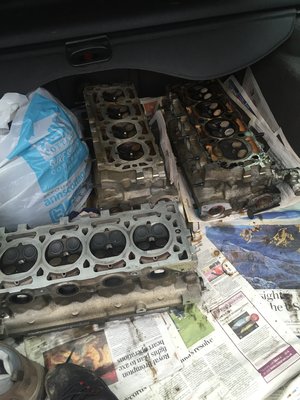
On starting to strip the head originally from the Landie, I made a couple of additional discoveries:
1. On releasing the cam rail from the head, there was no jointing sealant whatsoever between the two metal surfaces. This explains the oil collecting around the spark plugs, and why the engine block is caked with oil and dirt!
Picture below taken after just wiping the oil away... there should be a residue of sealant that needs to be scraped away:
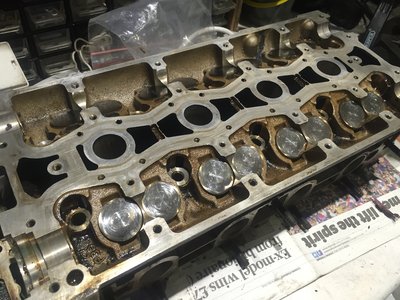
2. The cam bearing surfaces are scored I fear I may need to track down a pair of standard MPi cams now...
I fear I may need to track down a pair of standard MPi cams now... 
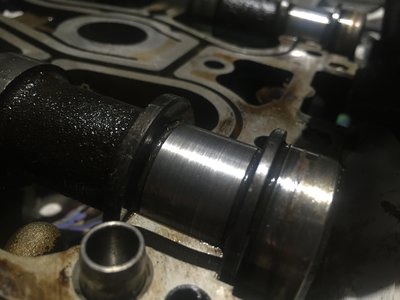
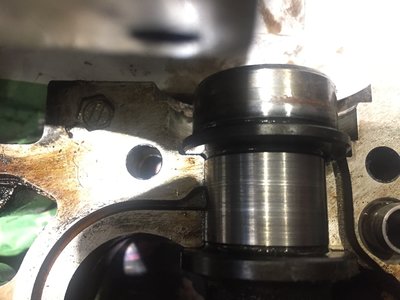
On starting to strip the head originally from the Landie, I made a couple of additional discoveries:
1. On releasing the cam rail from the head, there was no jointing sealant whatsoever between the two metal surfaces. This explains the oil collecting around the spark plugs, and why the engine block is caked with oil and dirt!
Picture below taken after just wiping the oil away... there should be a residue of sealant that needs to be scraped away:
2. The cam bearing surfaces are scored
Alibro
Well-Known Member
- Posts
- 7,449
- Location
- Northern Ireland
I wonder how many people catch on to HGF and do something about it before it overheats?
I suspect more times than not they end up being driven home in plumes of steam, hence the common repeat failure rate.
I suspect more times than not they end up being driven home in plumes of steam, hence the common repeat failure rate.
At the first sign of failure, pull over where safe and stop the engine immediately to investigate.
That is precisely what hasn't happened here. In fact, judging by how brown all the seals are (cam seals, inlet manifold seal), this engine has been very, very cooked by someone or some people with zero mechanical sympathy.
I am surprised it isn't a molten lump of aluminium to be honest - and how it ran at all is a bit of a mystery.
I am now wondering what state the crank journals and bearing surfaces are in? I need to give this some thought.
That is precisely what hasn't happened here. In fact, judging by how brown all the seals are (cam seals, inlet manifold seal), this engine has been very, very cooked by someone or some people with zero mechanical sympathy.
I am surprised it isn't a molten lump of aluminium to be honest - and how it ran at all is a bit of a mystery.
I am now wondering what state the crank journals and bearing surfaces are in? I need to give this some thought.
Alibro
Well-Known Member
- Posts
- 7,449
- Location
- Northern Ireland
Oh yeah! Turbo time. 




Edit: Sorry that came across as very uncaring for your predicament.
That's cause....
It's Turbo time.


Edit: Sorry that came across as very uncaring for your predicament.
That's cause....
It's Turbo time.
LOL!
Actually four options:
1. Rebuild current engine with good cylinder head.
2. Rebuild spare standard MPi engine with good cylinder head
3. Fit the spare 145PS VVC engine (will need converting from MEMS2J to MEMS3, but not too difficult to do
4. Fit one of the turbo blocks and either turbo or supercharge it
For now, and for insurance purposes, much easier to go for one of the first two options. But keeping an open mind for what would be the simplest/quickest option for getting this car back on (and off) the road
Actually four options:
1. Rebuild current engine with good cylinder head.
2. Rebuild spare standard MPi engine with good cylinder head
3. Fit the spare 145PS VVC engine (will need converting from MEMS2J to MEMS3, but not too difficult to do
4. Fit one of the turbo blocks and either turbo or supercharge it
For now, and for insurance purposes, much easier to go for one of the first two options. But keeping an open mind for what would be the simplest/quickest option for getting this car back on (and off) the road
Similar threads
Freelander 2 (LR2)
Trim colour code
- Replies
- 1
- Views
- 291
